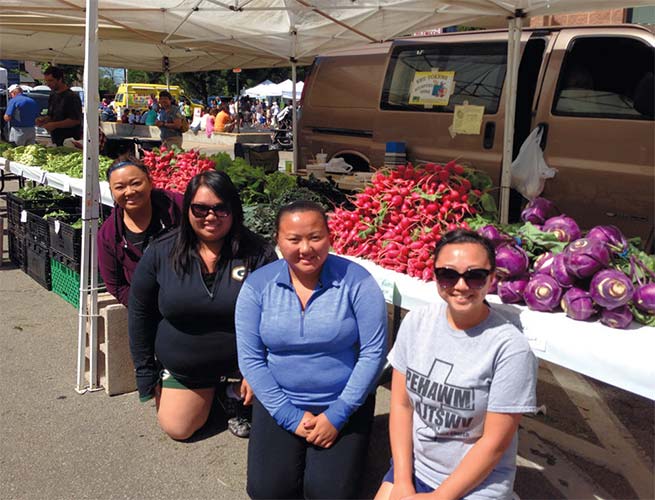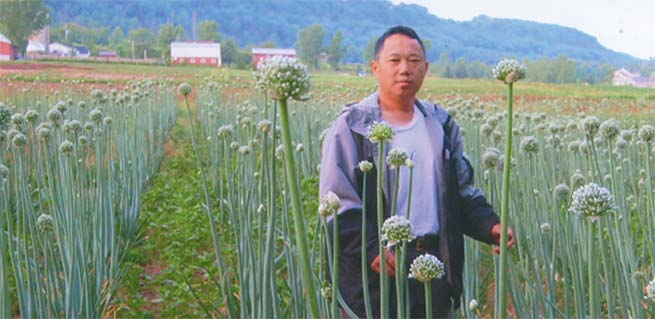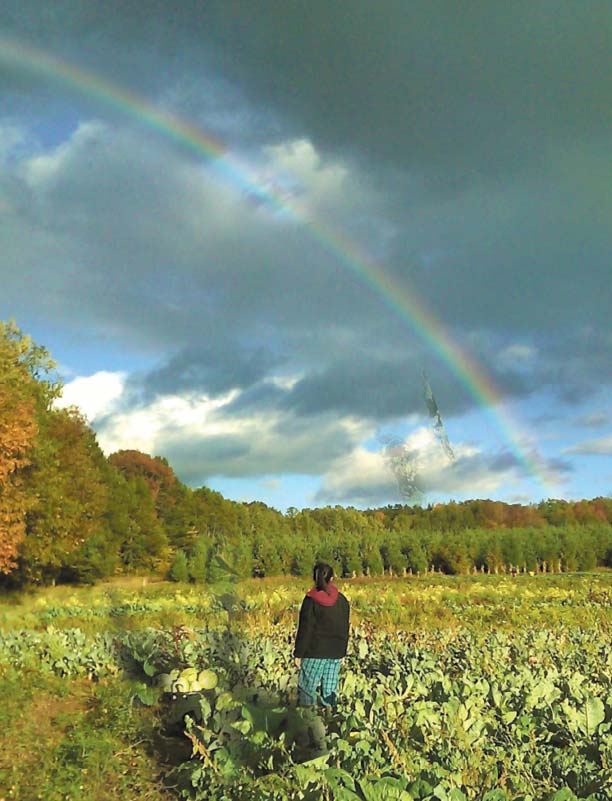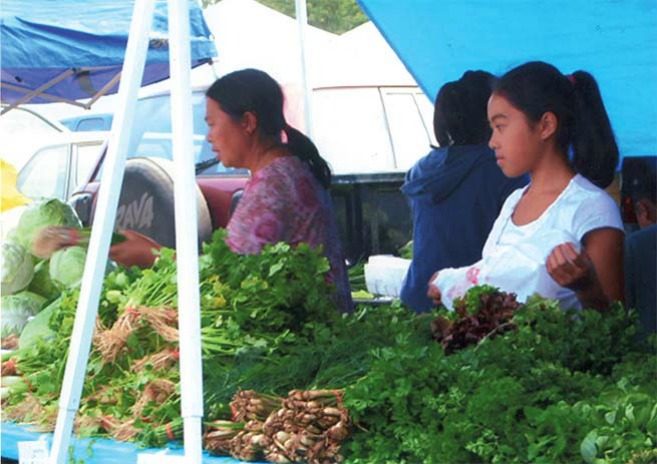Meet Your Farmer: Hmong Presence at Green Bay Farmers Markets
Soung Family Representative Of Hmong Presence & Popularity
edible Door archive from 2016 refreshed in 2024 for edibleNEW premiere
Story by Colleen Riordan
“We’ve been farming my whole entire life. No summers off,” Julie Soung laughs. “It’s like a second job. Work. Go to the garden or go sell. It’s crazy, but it keeps us busy.”
The Soung Family has planted, harvested and gone to market for as long as Julie Soung can remember. She has a degree from University of Wisconsin-Green Bay. The dutiful daughter works all day and then returns home to help her parents and ten siblings on the farm.
Every day of the week is spent tending the gardens, preparing produce for orders, or working the market stalls.
“My parents are the hard workers. They are retired, but they head to the gardens in the morning and don’t get back until it’s pitch black. We call it their second home.”
Many of her older siblings have started their own families and cannot help out as often anymore. However, they will pitch in by cooking dinner for the weary farmers who come in from the fields for the night.
“It’s a family affair. It’s not ‘if you’re not busy’. Whether you’re busy or not, you go home to help. We just do it. No complaining. Do it for our parents because this money is for them,” said Soung. “My parents came over because of the Vietnam War. It was either you leave or they are going to harm you. They had no choice to come over here. It was very difficult for them.”
Neither of her parents, Pha Soung and Ong Lor, spoke English when they arrived in the United States with their oldest daughter. They lived in Dixon, IL, for a few years before moving to Green Bay. There was already a growing Hmong community in the small city and it would bring them closer to many of their relatives.
“My parents are the hard workers. They are
retired, but they head to the gardens in the
morning and don’t get back until it’s pitch
black. We call it their second home.”
— Julie Soung

From left, sisters Julie Soung, Kathy Soung, Emily Soung and Sarah
Soung in front of their stand at the Green Bay Farmers Market.
Most of the Soung’s extended family is spread over the Midwest. However, one of her father’s siblings remains in Laos. When the rest of the family emigrated, he “got lost on the way,” said Soung. About ten years ago, the family was finally able to reconnect, but her father still has not seen his brother since the war.
“My parents always talk about going back. They say, ‘Life was so much easier over there. I want to go back and live the simple life. No bills to pay. No rules. We could just do it and live peacefully.’”
On a mission trip to Myanmar a few years ago, Soung began to better understand the life her parents left behind. Rules and regulations are not followed or enforced the way they are in the United States. It might be chaotic but simplicity can be found in their independence.
“I really want to take them back one day, but, right now, they just really want to farm and save up.
“They lived in the mountains, so they farmed on these steep hills. All they did was farm, but they lived an easy life. They have said life is much more difficult over here. You can’t just live off the garden the whole time.
“Now it’s a lot of traveling between our farms and to the markets. We lease a few plots of land. When my parents were in Laos, it was just one big plot of land that they lived on.”
The Soung’s three farms are located in De Pere, Denmark, and New Franken. It costs time and effort to trek from farm to farm, making sure the plants survive Wisconsin’s fickle weather during the early planting season. With a large family, the work is manageable, but it requires everyone to pitch in.
While many of the farming traditions Julie Soung’s parents grew up with can’t be replicated on Wisconsin soil, they still work the farms by hand.
“All the tools we use are handmade. Everything is manual labor. Someone’s digging a line. Someone’s digging a hole. Someone’s planting. When we till, it’s a manual machine.”
When they are not on the farms, working, or in school, the Soung children run stalls at both the Wednesday night and Saturday morning farmers markets in downtown Green Bay.
“You have to be committed to doing the farmers market because we go every Saturday. Some nights we don’t finish prepping, cleaning, and washing our vegetables until midnight, and then we wake up at 4 o’clock to go sell.”

Jacob Soung in the fields. Contributed photo
When the Saturday Farmers Market was located in the Cherry Street lot, the family was a daily vendor. The market was first come, first serve, so they had to wait every morning to see whether they would be granted space.
They became permanent vendors and were grandfathered in with a rare three booths at the Saturday market. Julie Soung and four of her sisters work the stalls, while the rest of her family continues farmwork.
“We can’t have less than four people there on a Saturday. It gets really busy. Rain or shine you have to be there.”
Their consistently delicious produce and low prices have built up a long list of regulars over the years. The Soung girls love getting to know their customers and being involved in the community.
“Originally, we catered to the Hmong people, but we realized that’s not our only target. So we started doing carrots, kale, collard greens and a lot more. We have a variety of vegetables.”
The family often sells their vegetables to area restaurants including Bangkok Gardens, Hinterland and Titletown Brewing Company. The chefs pick through the market, basket in hand, to buy fresh produce for the day’s menu.
After the markets close at the end of summer, the Soungs will harvest everything that they did not sell and freeze it. From November to January, they will start buying their seeds and enjoy the rest. The organization and early preparation begins at the start of the year. In March, planting begins, starting the cycle over again.
“There are easier ways to make a living, but my parents just love doing this.”

It's Been a Long Journey to the Farmer's Market
Story by Jon Gast
In many ways the Hmong have become a prominent face in farmers markets throughout Wisconsin. As lovely and peaceful as the people are standings amidst their remarkable assortment of produce and colorful flowers, their story is one that is all too similar to one we see on the news nearly every night.
As refugees fl ee by the thousands from the war-torn Middle East, the debate has raged here in the United States as to our involvement. Frankly, it is nothing new as waves of immigrants have come to this country for much of our existence to escape religious and political persecution as well as famine and draught.
The Hmong provide one of the more interesting chapters in this story of how America became known as the world’s pre-eminent melting pot of races and cultures.
It’s very likely that many who shop at one of their market booths aren’t aware of the role the Hmong played in the Vietnam War and how that ultimately led to their arrival in America.
It can all be traced back to Central Siberia. Eventually, the Hmong migrated to Northern China and then further south as these primarily agrarian people populated the fertile lands of the Yellow River.
War drove them onward to Hunan and Hupeh provinces where they established a separate kingdom spanning from the fourth to the tenth century A.D. But centuries of conflict and persecution followed and the Hmong continued to fl ee to the south.
During the mid-nineteenth century, thousands of Hmong crossed into Vietnam, Laos, Thailand and Myanmar. After World War II, the French had a strong presence in Southeast Asia and were followed by the United States in the Vietnam conflict.
According to the National American Hmong Farmers (NAHM), the Hmong supported both foreign powers. In Laos they were the cast of guerrilla fighters hired by the CIA in the secret war against Laotian communists. In 1975 communists gained control of Laos and the U.S. pulled out. The Hmong had no choice but to surrender or flee. Most chose to escape to Thailand, crossing the Mekong River to live in refugee camps. After the U.S. government officially acknowledged the American presence in Laos and the aid of the Hmong soldiers, the Hmong began to immigrate to the U.S. among other countries.
Enter Barbara Biebel of the Roman Catholic Diocese of Green Bay. As Director of Refugee, Migration and Hispanic Services for the diocese, Biebel was confronted with the initial wave of Hmong immigrants. Wisconsin would eventually have the third largest Hmong population of any state in the country.
But her job really began with the resettlement of the Vietnamese in 1975, a situation Biebel said wasn’t too much different from World War II when the government turned to privately run social agencies such as church organizations to handle the infl ux of displaced people. But the Vietnamese culture proved as foreign for the aide workers as life in America was for the immigrants.
“I went to the Vincent DePaul store and bought as many National Geographics on the Vietnamese as I could,” said Biebel.
Between July and December of 1975, Biebel helped settle 300 Vietnamese in the dioceses.
It seemed appropriate to try and settle these refugees on farms but, as Biebel points out, the agricultural styles were as different as the miles that separated the Vietnamese and American cultures.
“I felt we needed to get them back to what they knew and loved,” she said, referring to farming. But she soon realized that the Vietnamese, and soon after the Hmong, did what nearly every previous immigrant in American history had done.
“They clustered together for mutual support,” said Biebel. “It takes a while to learn a new language. This was a cultura that hadn’t changed in hundreds of years.”
The Hmong presented an even more serious challenge to Biebel who felt she had weathered the bulk of the post-Vietnam War immigration. But the Hmong had been a willing and vital U.S. partner against the communists and the United Stated initially blocked efforts to resettle them in the United States.
“These people were true refugees,” said Biebel, who heard firsthand accounts of the brutality these people without a country faced as they tried to flee the communists from Laos into Thailand. Much like the Syrians today in Turkey, makeshift camps were set up in Thailand.
“These people faced the fear of death,” said Biebel, who went back to National Geographics to learn as much about the Hmong as possible. “Remember this was before there was anything like the Internet.”
What she learned was that these were almost entirely agricultural people.
According to NHAM, “In Laos, the Hmong practiced slash and burn farming. After choosing an area, they would clear away brush, pile it and use it to burn all the trees and plant life. The ash was spread throughout the field as fertilizer.”
As Biebel found, Wisconsin farming, especially dairy operations in the case of one particular family, proved both foreign and isolated to these immigrants. Unlike the Vietnamese, the Hmong migration was far more gradual, spanning nearly 30 years often spurred by family reunification.
But the Hmong, just as their ancestors for centuries before, adjusted to the change that had been brought on by migration. And while the young attended school, gradually learned English and were assimilated into American culture, the elders found it a struggle.
Again farming was vital in helping the Hmong adjust and it was the emergence of community gardens that played a key role. Biebel said plots were available and these where particularly helpful for many of the older Hmong, many of whom had brought seed with them from the motherland.
But the Hmong also found work on farms and gradually put enough money away to buy a few acres and that has led to their emergence on the farmers market scene and right back to where this particular article started.





